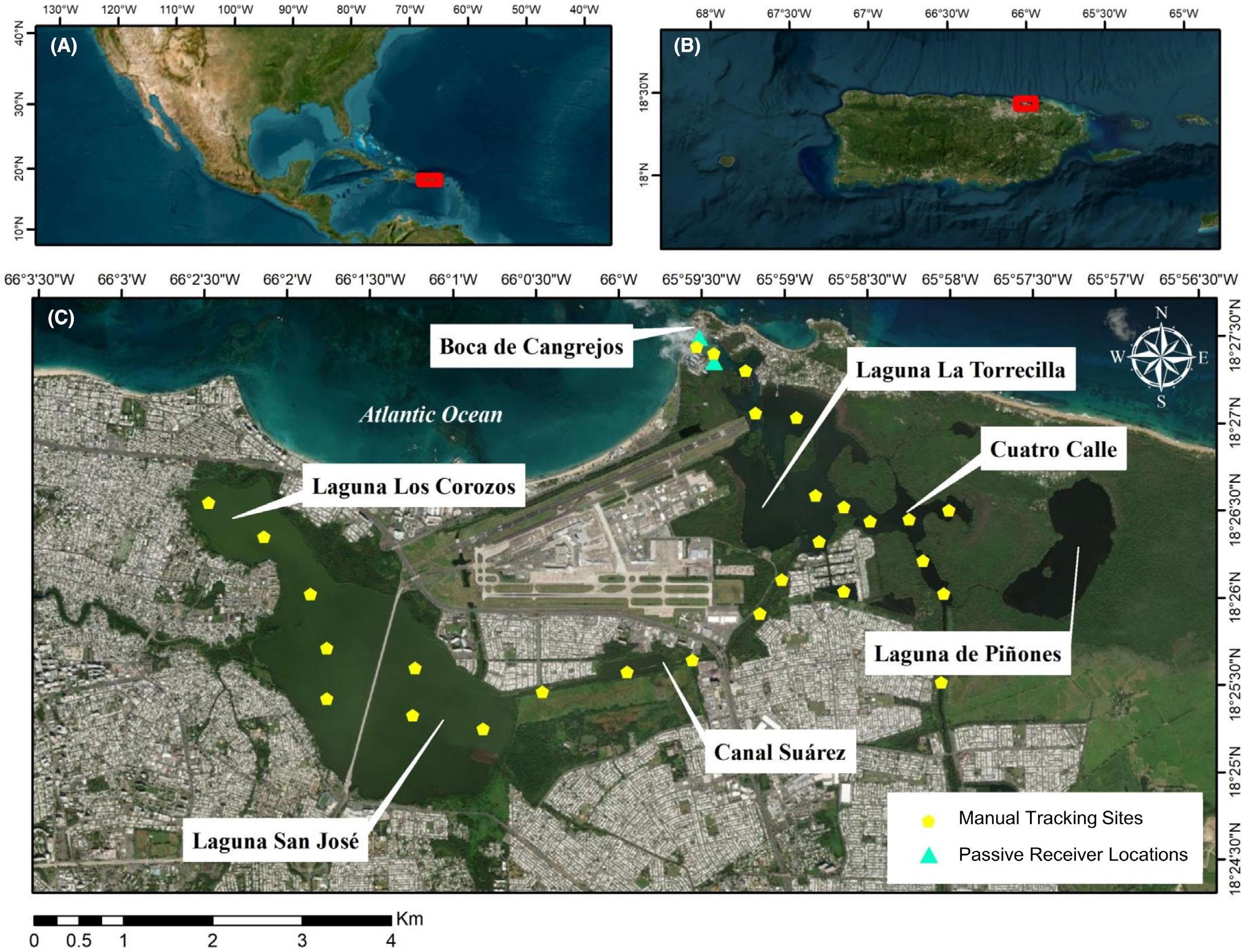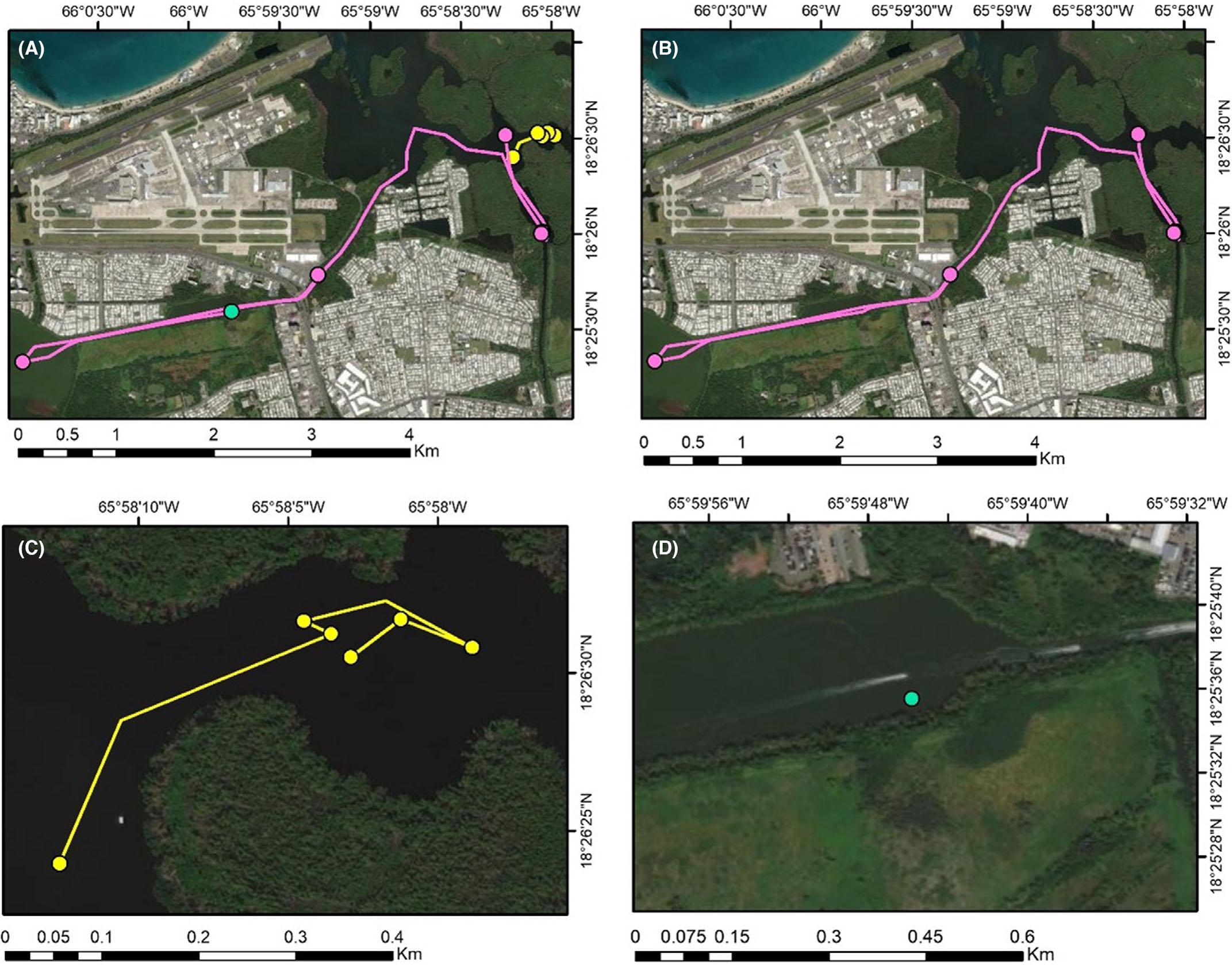
MarineandCoastalFisheries:Dynamics,Management,andEcosystemScience 15:e10238,2023
© 2023TheAuthors. MarineandCoastalFisheries publishedbyWileyPeriodicalsLLConbehalfofAmericanFisheriesSociety. ISSN:1942-5120online DOI:10.1002/mcf2.10238


MarineandCoastalFisheries:Dynamics,Management,andEcosystemScience 15:e10238,2023
© 2023TheAuthors. MarineandCoastalFisheries publishedbyWileyPeriodicalsLLConbehalfofAmericanFisheriesSociety. ISSN:1942-5120online DOI:10.1002/mcf2.10238
LauraB.Horowitz,PeterJ.Allen ,J.WesleyNeal,andSandraB.Correa* DepartmentofWildlife,FisheriesandAquaculture,MississippiStateUniversity,Box9690,MississippiState,Mississippi 39762,USA
Abstract
Tarpon Megalopsatlanticus isapopularandeconomicallyimportantinshoresport fishinPuertoRico,andthe pursuitofthisspeciesbylocalanglersandtouristscontributestotheeconomy.Thisspeciesismanagedasano-take fishery,whichaimstopreservepopulationsbycatchingandreleasing fishthatwouldotherwisebesubjectedtoharvest andremovalfromthepopulation.Theapproachassumesminimalmortalityand/orreduced fitnessofreleased fish,yet theprocessofanglingcanproducemanysublethalsideeffectsordirectmortality.Inthisstudy,charteranglingfor TarponintheSanJuanlagoonsysteminPuertoRicowasexaminedtodeterminepostreleasemortality.Angled fish wereexternallytaggedwithacoustictransmittersandrelocatedperiodicallytodeterminethefateafterrelease. Postreleasemortalitywasatleast4.5%(two fishobserveddead)andatmost18.2%(observeddeadplusclassified deadbasedonlackofmovement;confidenceinterval[CI] = 7.5–28.9%).Sometaglosswasobserved,whichcould havearti ficiallyelevatedclassifiedmortalityestimates.Potentialfactorsthatcontributetomortalityarediscussedand comparedtotheliterature.Hooktype,gearaction,landingprocedures,andairexposurewerekeyareasofpossible improvement.Recommendationstominimize fishharmduringanglingincludetheuseofheavieractiongeartoreduce fighttime,acirclehookrequirementforlivebaittoreducedeephooking,maintaining fishinthewaterduringlanding andphotography,andlimitingairexposureto2minorlessif fishareremovedfromthewater.
Thegoalofcatch-and-releaseanglingisthatcaptured fishsurvivetobecaughtagain(PollockandPine 2007). Thisrequiresthat fi sharenotphysiologicallycompromisedafterrelease(Orr 2009).Despitetheintentofcatchand-releasepractices,anglingcancauseacutestressand physicaldamageto fi sh,withpotentiallethalorsublethal consequences(Mazeaudetal. 1977;Skomal 2006).Visible injuriesmayincludehookingwounds,physicaldeformities fromrepetitivehookingandhandling,andbacterial/fungal infections(Meka 2004).Subsequenttocapture, fishcan experiencerespiratoryissuesandcompromisedimmune systems,leadingtobehavioralchanges(Cookeetal. 2002; Wilsonetal. 2014).Otherphysiologicalimpairments includedamagetothere flexresponse,increasedriskof predation,anddecreasedindividual fitness(Campbell
*Correspondingauthor: sbc257@msstate.edu ReceivedMay25,2022;acceptedJanuary14,2023
etal. 2010;Brownscombeetal. 2017).Thesestressors mayactindividuallyorsynergisticallytoresultinthe deathofreleased fish.Mortalitymayvarybyduration andmagnitudeofthestressors(MekaandMcCormick 2005)andareinfl uencedbygeartype(Sassetal. 2018),environmentalconditions(Suskietal. 2006),and postcapturehandlingandreleasepractices(Guindon 2011).
Acoustictelemetryisoftenusedtodetermineinsitu mortalityoveraperiodofhourstoweeksfollowing release(Princeetal. 2002;FFWCC 2013).Forexample, RedSnapper Lutjanuscampechanus taggedwithacoustic transmittersdemonstratedanglingmortalityoccurred within72hfollowingrelease(EbertsandSomers 2017). ResultsfromacoustictelemetryofBone fish Albulavulpes
Thisisanopenaccessarticleunderthetermsofthe CreativeCommonsAttribution License,whichpermitsuse,distributionand reproductioninanymedium,providedtheoriginalworkisproperlycited.
suggestedangling-inducedmortalityoftenoccurswithin minutesof fishbeingreleased(Danylchuketal. 2007). Furthermore,43%of30Bone fishsuccumbedtoanglinginducedpredationwithina2-weektimespan(Moxham etal. 2019).Thesestudiesutilizedexternalattachmentof transmitterstoavoidintrusivesurgicalprocedures. Althoughexternaltagginghasbeenfoundtoreduce growthandlong-termsurvival,directmortalityfrom externaltaggingisrare(seereviewbyJepsenetal. 2015).
Tarpon Megalopsatlanticus isapopularinshoresport fishspecies,andthispopularityderivesfromitslargesize, powerful fightwhenhooked,andaccessibility,asTarpon aremainly fishedinshoreandincalmcoastalwaters (Guindon 2011).InPuertoRico,thepursuitofthisspeciesbylocalanglersandislandvisitorscontributessignificantlytotheeconomy(Garcia-Molineretal. 2002). However,Tarpon fisheriesinPuertoRicopreviouslywere pronetopopulationdeclinesduetoanglingandharvest (Zerbietal. 2001).Between2000and2003,upto10,189 kgofTarponwereharvestedannually,withnegative effectsonpopulationsize(GuerreroPérezetal. 2013).In response,thePuertoRicoDepartmentofNaturaland EnvironmentalResources(DNER)imposedaharvest prohibitiononTarponin2004toprotectstocksfor anglingbylocalsandtourists(GuerreroPérez etal. 2013).Currently,Tarponanglingisonlycatchand releaseinPuertoRicobylaw.
Dataoncatch,anglingeffort,andpostreleasemortalityofTarponhavenotbeencollectedinPuertoRico (GuerreroPérezetal. 2013).Guindon(2011)and Edwards(1998)reportedlowpostreleasemortalityin SouthFlorida,buttheresultsmaydifferfor fishangled inotherlocations.Tarponarewidelydistributed(WinemillerandDailey 2002),andenvironmentalparameters (i.e.,waterqualityandchemistry;Leichteretal. 2006) andvaryinganglingtechniques(Brownscombe etal. 2017)mayinfluencethepostreleasefateof fish. Therefore,thisstudyevaluatedcatch-and-releasemortalityofrecreationallyangledTarponinPuertoRicousing acoustictelemetry.Thespeci ficresearchobjectivewasto evaluatethefate(aliveordead)ofTarponusingacoustictelemetry.Factorsinfl uencingpostreleasefatearediscussed,andthisinformationcanbeusedtodecreasethe impactofcatch-and-releaseanglingontheTarpon fishery.
Studysite. SanJosé,LosCorozos,LaTorrecilla,and PiñonesLagoonandassociatedinterconnectedcanalslie withinthemetropolitanareaofSanJuan,PuertoRico (Figure 1)andarecollectivelyidentifi edasoneofthe world'stopTarponanglingdestinationsbythemedia. Tidalcyclesinfluencewaterqualityandsalinity,asdoes
rainfallinputviafeederstreamsandcanals.Lagoonsare surroundedbyredmangrove Rhizophoramangle,black mangrove Avicenniagerminans,andwhitemangrove Lagunculariaracemosaforests(Pooletal. 1977).Dueto dredging,landfills,andotheranthropogenicactivities,the hydrologicalcharacteristicsoftheestuaryhavechanged considerablyoverthepastcentury(Villanueva etal. 2000).Hydrologicalcharacteristicsthathavebeen alteredbyurbanizationintheSanJuanlagoonsystem includedisconnectionfromSanJuanBay,sedimentdenitrification,and fluxesofammonium,nitrate,andphosphorusnutrients(Pérez-Villalonaetal. 2015).These modi ficationshaveresultedinarelativelyclosedsystem withasinglesmallconnectiontotheAtlanticOcean throughthenarrowpassageofBocadeCangrejos,inthe localityofPiñones.
Anglingandtelemetry. Thisresearchwasconducted inpartnershipwithalocalchartercompanythatspecializesinSanJuanlagoonTarponangling.Theguides hostedresearchersoncharteredtripswithclientsfrom MaytoJuly2021.WhenaclienthookedaTarpon,informationabouttheanglingprocesswasrecordedfrom hooksetuntillanding.Here,theanglingprocessincluded fightduration,thenumberofjumps,rodaction(light, medium,orheavy),andhandlingondeck(i.e.,hook removalandbodysupportforphotography).Wealso recordedthegeographiclocationofcapture.Tarponwere onlycapturedusingspinningorbait-castinggear,withlive baitoncirclehooksduringthestudy.Tolandeach fish, theguidewouldgrabthe fishbythelowerjaw(hand lipped),and fishwerepulledintotheboatoverthegunwaleorbowandontothedeck.Dataonlandingconditionandproceduresincludedhooklocationonthe fish, observedinjurysuchasbleeding,andhandlingprocedure duringphotography.Onceclientsweredonewiththeir captured fi sh,itwashandedovertotheresearchersfor measurementoftotallength(mm)andpossibletag implantationpriortorelease.WerandomlyselectedTarponfortagimplantation.For fishnotselected,bloodwas drawnforanotherstudypriortorelease.
Transmitterimplantationandtelemetry. Acoustictag assembliesconsistedofaSonotronics(Tucson,Arizona) (CT-82-2-E)transmitterattachedtoatitaniumanchor(Ti Small,WildlifeComputers,Redmond,Washington)with astainless-steelleader(42.2kgtest,0.005cmdiameter) andcrimpsleeves(doublebarrelsize7,0.135cmdiameter).Thelengthoftheleaderwasadjustedto fishsizeso thatthetransmitterdidnotreachtoorinterferewiththe dorsal fi n.Tagassemblieswereattachedtothe fish'sleft side,twoscalerowsbelowtheinsertofthedorsal fin. Usingforceps,twotofourscaleswereremovedfromthe locationoftaginsertiontofacilitateimplantationofthe anchor.Thetaganchorwasinsertedwithatagpole(comprisedbyAZ-TAGPOLE-004;SwobbitTaggingPole

FIGURE1.Mapof (A) thelocationofPuertoRicointheCaribbeanSea, (B) thelocationoftheSanJuanlagoonsysteminPuertoRico,and (C) a close-upoftheSanJuanlagoonsystemandsurroundingareawiththelocationoftrackingsitesandpassivereceivers;BocadeCangrejosconnectsthe systemtotheAtlanticOcean.MapswereproducedbyKaroldCoronado-Franco.
16.51cmlength,AZ-DARTBUSH-001;DartBushing fi ts 1.91cmpole,andAZ-DARTAPP-011;DartApplicator1/ 4–28;WildlifeComputers)withinthescaleremovalzone throughthemusculatureandbetweenthepterygiophores. Fishwereimmediatelyreleasedbacktothesiteofcapture.
Relocationeffortswereconductedusingactivetracking onceperweekwithaSonotronicsManualTrackingKit (MANTRAK;whichcontainsaUSR-14receiver,DH-4 directionalhydrophone,TH-2towedomnidirectional hydrophone,andaccessories).Priortothestudy,researchersestablished28listeningstations,eachselectedtooptimizelagooncoveragebyutilizingamaximumlineofsight distanceofnomorethan1kmbetweenlisteningzones (Figure 1).Duringeachtelemetryperiod,theboatwas
maneuveredtoeachlisteningstationandtheomnidirectionalhydrophonewasloweredintothewaterandallfrequencieswerescanned.Whenatagged fishwasdetected, approximatelocationwasdeterminedusingthedirectional hydrophone.Whenalltagfrequencieshadbeenscanned, theboatwasmaneuveredtothenextlisteningstation.
BecauseTarponarehighlymobile(e.g.,Duffi ng Romeroetal. 2021),thelagoonsystemislargeandcomplex,andtimetoconducttelemetrywaslimitedto1dper week,exactlocationsusingtriangulationwerenotdetermined.Instead,theprotractedtelemetryperiodwasused tocon firmwhethera fishwasnonmobileandpresumed deadormobileandalive.Inthisstudy,postreleasefate wasassessedbyrelocating fishweeklyforupto9weeks. Thepostreleaseevaluationperiodwassetat5d,soto
classifya fishasalive,movementmustbedetected5dor moreafterrelease.
Classifi cationrulesweredevelopedtointerpret fishstatus basedonmovement(seeFigure 2 forexamples).Ruleswere basedonpreviousstudiesthatinferred fi shstatusbyclassifyingandgroupingpatternsoftelemetrydatafromreceivers (HeupelandSimpfendorfer 2002;Villegas-Ríosetal. 2020; Weinzetal. 2020).Fora fishtobeconsidered “alive,” it mustmeet allthree ofthefollowingcriteria(Figure 2B):
1. fishwererelocatedattwoormoredifferentlistening stationsatleast1weekapart;
2.observedmovementoccurredatleast5dafterrelease (indicatingitwasalivethrough5d);and
3.listeningstationscannothaveoverlapping fi eldsof detection(i.e., >1km).
Fora fishtobeconsidered “dead,” itmustmeet any of thefollowingcriteria(Figure 2C):
1.duringallweeklydetectionsafterday5withaminimumofthreedetections, fishwasdetectedinthesame area(withinthe1kmreceiverrange);
2.researchersrecoveredthedead fish;or
3.researchersreceivedreportsofa fi shbeingdeadwithin the5-devaluationperiod,anditwasrelocatedinthe reportedlocationfortwoormoreweeklytracking periods.

FIGURE2.Examplesof fishmovementandstatusclassificationasalive,dead,orcensoredbasedonrules. (A) Comparativemapofallthree classificationsrepresentedbypanels(B–D). (B) Fishconsideredalivebecauseofsignificantlymovementafter5d. (C) Fishconsidereddead,asit movedfromtheinitialsiteofcapturebutdidnotmovesignificantlyfollowingthe5-devaluationperiod. (D) Fishunabletobeclassifiedandcensored fromanalyses.MapswereproducedbyKaroldCoronado-Franco.
Fora fi sh'sstatustobeunknownandthedata “censoredfromanalyses, ” itmustmeet any ofthefollowing criteria(Figure 2D):
1.the fishwasfoundjustonce(indicatingitcouldhave leftthesystem,experiencedtagfailure,etc.);
2. fishhadonlytwodetections,withthe fi rstdetection occurringwithinthe5-devaluationperiod;or
3. fishhadonlytwodetectionsinthesamelocationor overlapping fieldsofdetectionimmediatelyfollowing the5-devaluationperiodonconsecutivetrackingdays andthendisappeared.
TwopassiveSubmersibleUltrasonicReceivers(SURs; Sonotronics)wereplacedatthemouthofthelagoonsystem todetermineif fishexitedtotheAtlanticOcean(Figure 1). Beforedeployment,passivereceiverbodies(excludingthe transducer)werewrappedinblackplasticandelectrical tapetoreducebiofouling.MountswereconstructedofPVC poles(5.08cmdiameter × 1.22mheight)insertedinconcretebases;PVCwasspray-paintedblackforconcealment. ReceiverswereattachedtoPVCmountswith550paracord andnyloncableties.Oncedeployed,SURmountswere tetheredtodockpylonstopreventlateralmovement.
Dataanalysis. SurSoftDPCsav1.0.8(c1)software (Sonotronics)wasusedtodownloadandanalyzepassive receiverdata.Detectionsfromthesereceiverswerecombinedwithactivetelemetrydatafortheassessmentof fish status.Combined fishlocationdatawereplottedinArcMap(10.8.1)toanalyze fi shmovementfordetermination of fi shstatus.Satellitebasemapswereretrievedfromthe ArcGISwebsite(ESRI; https://www.esri.com/).Confi dence intervalsformortalitywerebasedonmethodsusedby Wilde(2002)todeterminecon fidenceofstatusaround fish usingacoustictracking.
Summarystatisticsincludedall fishcaughtduringthestudy (includingthosenotreceivingtransmitters).Linearregression assessedwhether fishsizeinfluencedthedurationofthe fight. Priortoregression,theresponseandpredictorvariableswere log-transformedtocorrectfornormalityandtolinearizethe relationship.RegressionwasimplementedinR(version4.1.3; RFoundationforStatisticalComputing,Vienna).
AnglingProcess
Anglingprocedureswereevaluatedfor93angledTarponthatrangedfrom47to200(mean = 88)cmintotal length.Fishsizedirectlyinfluenced fighttime(adjusted r 2 = 0.55, P < 0.0001)(Figure 3).Fighttimerangedfrom 1to41minbutwasskewedtowardsshortertimeswitha mean(±SD)of5(±7)min.Observedjumpsrangedfrom 0to14(mean ± SD = 3 ± 2).

FIGURE3.Linearregressionshowingtherelationshipof fishtotal length(cm)with fighttime(min).
Thechartercompanywithwhomwepartneredprimarilyusedlightactionrods,livebait,andcirclehooksfor charteredanglingtrips(Figure 4).Withcirclehooks,most fishwerecaughtineitherthecornerofthemouthor upperjaw,andmost(90%)werereleasedafterthehooks wereremoved;however,whenhookingoccurredinthe throatordeeper,lineswerecutleavingthehookinplace toreduceinjury.Littletonobleedingwasobserved amongmostangled fi sh(Figure 4).Followinghook removal,clientscouldtakephotographswiththe fi shand choosethepositiontoholdthe fish.Horizontalphotographywasthemostpopularandencouragedbytheguides tobettergraspthe fish(Figure 4).Thispracticehadthe clientsupportthe fish'sbodyweightwithonehandonthe abdomenwhilecontrollingthe fishbyholdingthelipwith theotherhand.Larger fishwereoftenphotographedlying onthedeck.
TaggedTarponmovedconsiderablybetweenlagoons, suggestingthattheclassi ficationrulesbasedonmovement arevalid.Three fishweredetectedatthelagoonentrance, butno fishexitedtotheAtlanticOceanduringthestudy. Ofthe49tagged fi sh,5werecensoredfromfurtheranalysesduetoinsuffi cientdatatoclassifya fishasaliveor dead.Oftheremaining44classifi ed fi sh,36wereclassi fied asalivebasedonobservedmovementfollowingthe5-d evaluationperiod(81.8%).Conversely,eight fishwere classifiedasdeadbasedonlackofmovement(18.2%).

FIGURE4.Factorsduringtheanglingprocessthatcouldinfluencemortality.Rodaction(topleft),hookinglocation(topright),observedbleeding (bottomleft),andhandlingpositionduringphotography(bottomright)arepresented.
One fishdiedsoonafteranglingandthetransmitterwas retrieved;another fi shwasreported fl oatingdead,and althoughnotphysicallyrecovered,itwasrelocatedconsistentlyintheareareported.Thisyieldsacon firmedmortalityof4.5%(fishencountereddead),andapotential mortalityofupto18.2%estimatedusing fishstatuscriteria(fishconsidereddeadbasedonpostreleasemovement, includingcon firmedmortality).TheCIofthemortality estimateusing fishstatuscriteriawas7.5–28.9%.
Thisstudywasthe firsttoinvestigatecatch-and-release mortalitywithintheTarpon'stropicalrange.Mortality within5dofanglingwasatleast4.5%andatmost 18.2%,basedoncon firmedandclassi fiedmortalities, respectively.Thetwocon firmedmortalitiesoccurred within24hofrelease.Thissuggeststhatpostreleasemortalityoccursquickly,andthe5-devaluationperiodwas adequatetoassesstheeffectofangling.Itispossiblethat someclassifiedmortalitiesrepresentedtagshedding insteadof fi shdeathduringthe5-devaluationperiod,as thelossrateofexternaltransmitterscanbesubstantial
andhasbeenreportedtobeashighas100%insome studies(seereviewbyJepsenetal. 2015).TwoTarpon werereportedlycapturedbyotherchartersthathadscarringconsistentwithtagloss,andathirdwascaptured withthetetherinplacebutthetransmittermissing,lendingcredencetothisassertion.Thisstudydidnotcollect dataontagretention.Taglossthatoccurredaftertheinitialclassifi cationperiod(afterpostreleasemovementwas confi rmed)wouldnotaffecttheresults.
Therangeofpostreleasemortalityfromthisstudy wascomparabletooneestimatefromFlorida,where Guindon(2011)reporteda13%mortalityrate(95%CI: 6–21%)inangledTarpon(n = 82).Thatstudydescribed predationonreleasedTarponbysharkspeciestobea majorvectorofmortality(8.3%).Sharkpredationratesof nearly28%wererecordedinanotherlarge-scalesatellite taggingstudyofTarpon(n = 292)extendingfromNorth CarolinathroughouttheGulfofMexico(Luo etal. 2020).Suchahighpredationratebysharksmay, however,beanartifactofthestudysincesharksarelikely attractedtotheelectric fieldgeneratedbysatellitetags andthepredationrateincreasedinareaswithhighshark density(Luoetal. 2020).Thecurrentstudydidnot
observepredationonTarpon,andpredatorysharkspecies arenotcommoninthelagooncomplex.Anotherstudy fromFlorida(n = 27)reportedlowermortality(3.7%)of angledTarpon,andtheauthorsattributedthislowrateto anglingpractices,includingstyleandsizeofhook,useof heavygear,andaggressiveanglingtechniquestobringthe fishtotheboatasquicklyaspossible,andreleasingthe Tarponbynottakingitoutofthewater(Edwards 1998). Anglinginthecurrentstudyutilizedcirclehooks,which reduceddeephooking.However,lightactionspinning rodsweretheprimarygear,whichprolonged fighttimes andlikelyincreasedthetimeofphysicalandphysiological stress(Rothetal. 2018).Likewise,thePuertoRicocharter guidestypicallyremoveTarponfromthewaterforlandingandphotography,inducingadditionalstressandair exposure.
Certainfactorshavebeenidenti fiedintheliterature thatreducemortalityduringtheanglingprocess.Hooking locationcanaffectanglingmortalityinTarpon(Guindon 2011)andotherspecies(e.g.,RainbowTrout Oncorhynchusmykiss,Meka 2004).Potentiallylethalhooking locationscanincludetheeye,gills,andesophagus (Ostrandetal. 2005).Forexample,Derbio Trachynotus ovatus hookedinternallyhadan85%mortalityrate(Alós etal. 2008).Similarly,95%and75%ofSpottedSeatrout Cynoscionnebulosus diedwhenhookedintheesophagus andgills,respectively,comparedtoonly10%when hookedinthebonymouth(Jamesetal. 2007).Theuseof circlehooksinthecurrentstudycontributedtotheprevalenceofnonlethalhookinglocations(Cookeetal. 2003).
Most(n = 78)Tarponwerehookedinthecornerofthe mouthorintheupperorlowerjaw,withfew(n = 15) fish hookedinotherlocations(i.e.,outerheadorbody,inner oralcavity,oresophagus).
Most(91%)ofthe fishhadthehookremovedpriorto release.Onlyhooksthatweretoodeeptosafelyremove wereleftinthe fishbycuttingtheline.When fishhave deeplyingestedhooks,itisoftenmorebene ficialtoleave thehookintheindividual,asattemptingtoremovethe hookoftenresultsinadditionalinjuriesandincreased mortality(Butcheretal. 2007).InWhiteSeabass Atractoscionnobilis,forexample,leavingdeeplyembedded hooksincreasedsurvivalrates,and39%ofhooksthat weredeeplyingestedcouldpassthroughtheorganism's system(Aalbersetal. 2004).Whenlookingatsimulated anglinginSandWhiting Sillagociliate,23%of fishthat ingestedahookdied,butsurviving fishwereabletofeed, andsome fi shpassedingestedhookswithlimitedlongtermphysiologicalimpactsdocumented(McGrath etal. 2009).
Hookinglocationcandeterminewhetherbleeding occurs,especiallywhenthehookpenetratessoftorhighly vascularizedtissuessuchasthegillsandesophagus. Althoughsomebleedingwasobservedinthisstudy,76%
oftheindividualsexperiencednobleeding,withonlytwo individuals(2%)experiencingheavybleeding(gillhooked), oneofwhichwascon firmeddead.Previousstudieshave notedbleedingintensitywithhookinglocationcausing increasedmortality(e.g.,SchislerandBergersen 1996). Conversely,hookinglocationdidcorrelatewithbleeding intensitybutnotmortalityinArcticGrayling Thymallus arcticus (Casselman 2005).
Rothetal.(2018)assertedthatlonger fighttimesmay causephysiologicaldisturbancesthatcanleadtoagreater riskofpostreleasemortality.Increased fighttimeinShortfinMako Isurusoxyrinchus didincreasephysiological stressfactorssuchaslactateandglucosebutdidnot impactsurvival(Frenchetal. 2015).ForBrookTrout Salvelinusfontinalis,mortalitywasindependentof fight time(Kerretal. 2017).Similarly,Guindon(2011) reportedtheaverage fi ghttimeofTarponwas23.7min for fishthatsurvivedand16.5minfor fishthatexperiencedmortality,whichiscontrarytoRothetal.'s(2018) hypothesis.Themean fi ghttimeinthecurrentstudy(5 ± 7min)was3–5timeslessthantheGuindon(2011)study, despiteanglingprimarilyusinglightactiongear.Rod actionrelatestohoweasilyandwherealongtheshafta rodbendswhentensionisappliedtothetip.Manystudies previouslyhavenotedtheactionofthegearusedbutdid notrelateittoanglingmortality(Jones 2005;Danylchuk etal. 2014;Holderetal. 2020).Catchingthe fi shfaster reducestheintensityofthe fi ghtandstresstothe fi sh,but chartercompaniesmaypreferalongeranglingexperience forclients.Loweringtheactioncreatesmoreexcitingand challenging fi ghtforcustomers.
Thedisparityin fi ghttimebetweenGuindon(2011) andthecurrentstudywaslargelydueto fishsize. AlthoughlargerTarponarecapturedintheSanJuan lagoonsystem,the fisheryislargelysupportedbysmaller fish.Tarponevaluatedduringthecurrentstudyaveraged 88cmtotallength(±27cm),whereas fishintheFlorida evaluationaveraged160.8cmfor fishthatsurvivedand 146.5cmfor fi shthatexperiencedmortality(Guindon 2011).Thelackofarelationshipbetween fishsize andpostreleasemortalityreportedbyGuindon(2011)was furthersupportedbyameta-analysisofthecatch-andreleaseliterature(BartholomewandBohnsack 2005).This isasurprising findingbecauselarger fishtendtohave greater fighttimesandpresumablymoreangling-induced stressresponse(Guindon 2011).Fishsizewaspositively correlatedwith fi ghttimeandhandlingtimeinthecurrent study,andotherstudiessupportthis finding(e.g.,Danylchuketal. 2014;Pinderetal. 2017).ForBrookTrout, fighttimewasnotcorrelatedwithtotallength(Kerr etal. 2017),suggestingtherelationshipof fighttimeand lengthismostlikelyspecies-dependent.
Tarponcanbeacrobaticandleapfromthewater duringangling,attemptingtodislodgethehook
(Kokomoor 2010).Inacon finedmangroveenvironment liketheSanJuanlagoonsystem,jumpingbehaviorhas potentialtoinjureviaimpactwithmangrovesandother obstacles,orwiththewatersurface,butthishasnot beenempiricallyestablished(LuoandAult 2012).Inthis study,Tarponaveraged3(±2)jumpsduringtheangling process.Schlenkeretal.(2016)observedthatjumpingby WhiteMarlin Kajikiaalbida increases fishexhaustion andaddsadditionalstresstotheindividual(Schlenker etal. 2016).Further,jumpingbyangledRainbowTrout correlatedwithincreasedriskofinjury,asjumpingoften ledtodeeperhookwoundsandentanglementofthe fish intheline(Meka 2004).Itislikelythatjumpingbehaviorattheveryleastaddstothestressresponseduring angling.
Landingisarelativelystressfulprocess,particularly forlargerTarpon,whichweredraggedbythelowerjaw overtheedgeofthegunwaleorbowandintothe flooror deckofthevessel.IntheevaluationbyEdwards(1998), Tarponweresupportedinthewater,thuseliminatingair exposureandrelatedinjury,andsurvivalrateswerehigh, at96.3%.AlthoughTarponarefacultativeairbreathers (Geigeretal. 2000),thisraisesthequestionofwhether Tarponhavegreatersurvivalwhenleftinthewaterto preventairexposureandtheeffectsofgravityoutsidea liquidmedium.Watersupportstheweightofa fi sh,and removalfromthewatercancauseinjurytointernal organs,mandibularbonebreaksandseparatedtongue (Danylchuketal. 2008),andvertebralseparation(Gould andGrace 2009;Frawley 2015),andunexpected fish movementcanleadtoaccidentaldropsandimpactinjuries.Increasedairexposurehasbeencorrelatedwith increasedstressin fish(FergusonandTufts 1992;Brownscombeetal. 2017)andanincreasedamountoftime requiredforthe fishtorecoverfromthecaptureevent (Cookeetal. 2001;Brownscombeetal. 2017).Guindon(2011)suggestedlimitingairexposureofTarponto2 minorlessandreportednosigni fi cantphysiologicaldifferenceinbloodchemistryresponsewith1minairexposure.Whereasevidencesuggestslongerairexposurehas adverseeffectsonthesurvivabilityofsomespecies (ArlinghausandHallermann 2007),itmightbeadvantageoustominimizeairexposure,assuggestedby Edwards(1998)forTarpon.
Anglersliketosharetheirexperiencewithothers,especiallythroughphotography.Clientswereencouragedto hold fi shhorizontallysupported(58%)whentakingphotographs;onlyafew fish(13%)weresupportedvertically oronthedeck,particularlyforlarger fishduetotheir heavyweight.All fishweregentlyrevivedandreleased backintothewateraftercapture.Horizontallysupporting andgentlyreleasingthe fi shminimizesinjuryandstress (Frawley 2015).Practicingtheseeffortsarenowconsideredetiquetteandpartofsafehandlingpracticesofcatch-
and-releaseangling.Someresearchersrecommendleaving the fi shinthewaterforhookremovalandphotography, minimizingairexposureandpossibleinjury(Cookeand Sneddon 2007).
ItiscommonforTarpontoshow “partialmigration,” thatis,intraspeci ficvariationinmigrationdistance,andthespeciescommonlyresidesinestuarine habitatforpartoftheyear(Luoetal. 2020).The uniquenessoftheSanJuanlagoonnetworkisthat Tarponarecontainedwithinasemiclosedsystemand canonlyenterandexitviaashallowopening(Bocade Cangrejos,Figure 1C)thatisabout35mwide.Itis unclearwhetherTarponintheSanJuanlagoonnetwork areyear-roundresidentsormigrateoutofthesystem duringsomepartoftheyear.Inthisstudy,onlythree fishapproachedtheexittotheAtlanticOceanbutdid notleaveforanysignifi cantdurationwithinthe9-week observationperiod.If fishareyear-roundresidents,it raisesconcernabouthowcontinuousanglingpressure impactsindividualsconfi nedwithinasemiclosedsystem. Althoughtheanglingeffortwasnotmeasured,itissubstantial,withmanycharterout fitswithclientanglers andprivaterecreationalanglersusingtheirpersonal watercraftdaily.Itwascommonduringthisstudytobe targetingTarponwithinasmallareawith fi veormore otherboatsnearby.Further,telemetered fishfromthis studywerecaughtmultipletimesbydifferentangling charters,asresearchersreceivedmultiplereportsof tagged fishbeingcaught.Whilethisindicatesthatsome fishrecoverquicklyandreturntonormalfeedingbehavior(Cookeetal. 2013),italsosuggeststhat fi shinthis lagoon fisheryarerepeatedlyexposedtotheriskof injury,airexposure,andpostreleasemortality.
Cautioniswarrantedwhenusingtheuppermortality rateestimates,duetotheclassifi cationprocess.Immobile fishwereclassi fiedasmortalitieswithoutveri fication. Thereweretworeportsof fi shcapturedthatlookedlike thetagwaspulledoutandanotherthatwasdisconnected fromtheanchorline.Thisindicatesthattagshedding occurred,butthetimingandeffectiscurrentlyunknown. Taglosssoonaftertaggingwouldleadtopotentialfalse classificationsifthose fishsurvivedaftersheddingthetag. Further,thisresearchoccurredonlyduringthesummer. Althoughenvironmentalconditionsarerelativelystablein PuertoRico,someseasonalvariationoccursandcould influenceseasonalresults.Summerwatertemperaturesare greaterandthereforemayrepresentaperiodofgreater thermalstress.Finally,thisstudyassessedspeci fi cpracticesofasingleanglingcharteroperator.Theanglingand handlingtechniquesofotherchartercompanies,freelancingcaptains,andindependentanglersmaydiffer(Brownscombeetal. 2017).
Withoptimalanglingandhandlingpractices,catchand-releaseanglingcanbesuccessful,withminimal
mortality(Brownscombeetal. 2017).Anglertechniques canbealteredtominimizecatch-and-releaseangling fromhavingnegativeimpacts(BartholomewandBohnsack 2005).Hooktype,gearaction,landingprocedures, andairexposurewerediscussedasareaswheremodi ficationscouldyieldasigni ficantimprovementinpostrelease survival.Theuseofheavieractionrodsandgreaterline testcouldreduce fi ghttime,shorteningtheperiodof anglingstress(Mohanetal. 2020).Thismaynotbethe bestoptiontomaximizetheanglingexperience,asanglers pursueTarponforthe fight.Circlehooksarewellresearchedtoreducedeephooking,andacirclehook requirementwhenusingnaturalbaitcouldincreasepostreleasesurvival(seereviewsbyCookeandSuski 2004; Kelleretal. 2020).Maintaining fishinthewaterduring landingandphotographywouldeliminateairexposure andinjuriesrelatedtolifting fishfromthesupportwater provides(Edwards 1998).Ifthe fi shmustberemoved fromthewater,itisnecessarytoprovidesupporttothe bodyandreducepotentialforinjury.Finally,whenTarponareexposedtoair,theexposuretimeshouldbekept at2minorless(Guindon 2011).Althoughmostreleased Tarponsurvived,anglingpressureintheSanJuanlagoon systemisintenseandtheserecommendationscouldhelp reducetheriskto fishthataresubjectedtomultiplecaptureevents.
Theauthorsthankourpartnerchartercompany,CaribbeanFishingAdventures,includingA.Muntanerand guidesL.Valdivieso,Y.Sierra,G.Rodriguez,M.Muntaner,andF.Prieto,forworkingwithusthroughoutthe extentofthestudy.K.Coronado-FrancoaidedinGIS, spatialdataanalysis,andmappreparation.Fundingwas providedbyPuertoRicoSeaGrant(Grant2020-2021-007 toJ.W.Neal,P.J.Allen,andS.B.Correa),andadditionalsupportwasprovidedbythePuertoRicoDepartmentofNaturalandEnvironmentalResources,the DepartmentofWildlife,FisheriesandAquacultureat MississippiStateUniversity(MSU),MSUExtensionService,MSUForestandWildlifeResearchCenter,andthe U.S.DepartmentofAgriculture(NationalInstituteof FoodandAgriculture,Grant#1005154toP.J.Allenand Project#MISZ-081700toS.B.Correa).Thisresearch wasconductedincompliancewithprovisionsestablished inMississippiStateUniversityInstitutionalAnimalCare andUseCommittee(Protocol#20-277).Thereisnoconflictofinterestdeclaredinthisarticle.
PeterJ.Allen https://orcid.org/0000-0003-0122-9387
SandraB.Correa https://orcid.org/0000-0003-4466-6923
Aalbers,S.A.,G.M.Stutzer,andM.A.Drawbridge.2004.Theeffects ofcatch-and-releaseanglingonthegrowthandsurvivalofjuvenile WhiteSeabasscapturedonoffsetcircleandJ-typehooks.North AmericanJournalofFisheriesManagement24:793–800.
Alós,J.,M.Cerdà,S.Deudero,andA.M.Grau.2008.Influenceof hooksizeandtypeonshort-termmortality,hookinglocationandsize selectivityinaSpanishrecreational fishery.JournalofApplied Ichthyology24:658–663.
Arlinghaus,R.,andJ.Hallermann.2007.EffectsofairexposureonmortalityandgrowthofundersizedPikeperch, Sanderlucioperca,atlow watertemperatureswithimplicationsforcatch-and-release fishing. FisheriesManagementandEcology14:155–160.
Bartholomew,A.,andJ.A.Bohnsack.2005.Areviewofcatch-andreleaseanglingmortalitywithimplicationsforno-takereserves. ReviewsinFishBiologyandFisheries15:129–154.
Brownscombe,J.W.,A.J.Danylchuk,J.M.Chapman,L.F. Gutowsky,andS.J.Cooke.2017.Bestpracticesforcatch-and-release recreational fisheries–anglingtoolsandtactics.FisheriesResearch 186:693–705.
Butcher,P.A.,M.K.Broadhurst,D.Reynolds,D.D.Reid,andC.A. Gray.2007.Releasemethodandanatomicalhooklocation:effectson short-termmortalityofangler-caught Acanthopagrusaustralis and Argyrosomusjaponicus.DiseasesofAquaticOrganisms74:17–26.
Campbell,M.D.,R.Patino,J.Tolan,R.Strauss,andS.L.Diamond. 2010.Sublethaleffectsofcatch-and-releaseangling:measuringcapturestress, fishimpairment,andpredationriskusingacondition index.ICESJournalofMarineScience67:513–521.
Casselman,S.J.2005.Catch-and-releaseangling:areviewwith guidelinesforproper fishhandlingpractices.OntarioMinistryof NaturalResources,FishandWildlifeBranch,FisheriesSection, Peterborough.
Cooke,S.J.,M.R.Donaldson,C.M.O'Connor,G.D.Raby,R. Arlinghaus,A.J.Danylchuk,K.C.Hanson,S.G.Hinch,T.D. Clark,D.A.Patterson,andC.D.Suski.2013.Thephysiologicalconsequencesofcatch-and-releaseangling:perspectivesonexperimental design,interpretation,extrapolationandrelevancetostakeholders. FisheriesManagementandEcology20:268–287.
Cooke,S.J.,D.P.Philipp,K.M.Dunmall,andJ.F.Schreer.2001. Theinfluenceofterminaltackleoninjury,handlingtime,andcardiac disturbanceofRockBass.NorthAmericanJournalofFisheriesManagement21:333–342.
Cooke,S.J.,J.F.Schreer,D.H.Wahl,andD.P.Philipp.2002.Physiologicalimpactsofcatch-and-releaseanglingpracticesonLargemouth BassandSmallmouthBass.Pages489–512 in D.P.PhilippandM.S. Ridgway,editors.Blackbass:ecology,conservation,andmanagement.AmericanFisheriesSociety,Symposium31,Bethesda,Maryland.
Cooke,S.J.,andL.U.Sneddon.2007.Animalwelfareperspectiveson recreationalangling.AppliedAnimalBehaviorScience104:176–198.
Cooke,S.J.,andC.D.Suski.2004.Arecirclehooksaneffectivetool forconservingmarineandfreshwaterrecreationalcatch-and-release fisheries?AquaticConservation:MarineandFreshwaterEcosystems 14:299–326.
Cooke,S.J.,C.D.Suski,B.L.Barthel,K.G.Ostrand,B.I.Tufts,and D.P.Philipp.2003.Injuryandmortalityinducedbyfourhooktypes onBluegillandPumpkinseed.NorthAmericanJournalofFisheries Management23:883–893.
Danylchuk,A.J.,A.Adams,S.J.Cooke,andC.D.Suski.2008.An evaluationoftheinjuryandshort-termsurvivalofBonefish(Albula spp.)asinfluencedbyamechanicallip-grippingdeviceusedbyrecreationalanglers.FisheriesResearch93:248–252.
Danylchuk,A.J.,S.E.Danylchuk,S.J.Cooke,T.L.Goldberg,J.B. Koppelman,andD.P.Philipp.2007.Post-releasemortalityof
Bonefish, Albulavulpes,exposedtodifferenthandlingpracticesduring catch-and-releaseanglinginEleuthera,TheBahamas.FisheriesManagementandEcology14:149–154.
Danylchuk,A.J.,C.D.Suski,J.W.Mandelman,K.J.Murchie,C.R. Haak,A.M.Brooks,andS.J.Cooke.2014.Hookinginjury,physiologicalstatusandshort-termmortalityofjuvenileLemonSharks (Negaprionbevirostris)followingcatch-and-releaserecreational angling.ConservationPhysiology2(1):cot036.
DuffingRomero,M.D.,J.K.Matley,J.L.Luo,J.S.Ault,S.J.Pittman,andR.S.Nemeth.2021.MovementpatternsofjuvenileAtlanticTarpon(Megalopsatlanticus)inBrewersBay,St.Thomas,U.S. VirginIslands.AnimalBiotelemetry9:article16.
Eberts,R.L.,andC.M.Somers.2017.Ventinganddescendingprovide equivocalbenefitsforcatch-and-releasesurvival:studydesigninfluenceseffectivenessmorethanbarotraumareliefmethod.NorthAmericanJournalofFisheriesManagement37:612–623.
Edwards,R.E.1998.SurvivalandmovementpatternsofreleasedTarpon(Megalopsatlanticus).GulfofMexicoScience16(1):article1. Ferguson,R.A.,andB.L.Tufts.1992.Physiologicaleffectsofbriefair exposureinexhaustivelyexercisedRainbowTrout(Oncorhynchus mykiss):implicationsfor “catchandrelease” fisheries.CanadianJournalofFisheriesandAquaticSciences49:1157–1162.
FFWCC(FloridaFishandWildlifeConservationCommission).2013. Summaryreportonthecatch-and-releasemortalitystudyonTarpon inBocaGrandePass,2002–2004(revisedandupdatedSeptember11, 2013).FFWCC,FinalReport,Tallahassee. Frawley,J.2015.Kissing fish:RexHunt,popularculture,sustainability and fishingpractices.JournalofAustralianStudies39:307–325.
French,R.P.,J.Lyle,S.Tracey,S.Currie,andJ.M.Semmens.2015. Highsurvivorshipaftercatch-and-release fishingsuggestsphysiologicalresilienceintheendothermicShortfinMakoShark(Isurusoxyrinchus).ConservationPhysiology3(1):cov044.
Garcia-Moliner,G.,I.Mateo,S.Maidment-Caseau,W.J.Tobias,and B.Kojis.2002.Recreationalchartered fishingactivityintheU.S. Caribbean.Proceedingsofthe53rdAnnualGulfandCaribbeanFisheriesInstitute53:307–317.
Geiger,S.P.,J.J.Torres,andR.E.Crabtree.2000.Airbreathingand gillventilationfrequenciesinjuvenileTarpon Megalopsatlanticus: responsestochangesindissolvedoxygen,temperature,hydrogensulfide,andpH.EnvironmentalBiologyofFishes59:181–190. Gould,A.,andB.S.Grace.2009.InjuriestoBarramundi Latescalcarife resultingfromlip-grippingdevicesinthelaboratory.NorthAmerican JournalofFisheriesManagement29:1418–1424.
GuerreroPérez,C.R.,M.A.García,C.Lilyestrom,G.Rodríguez,and Y.Rodríguez.2013.PuertoRicomarinerecreational fisheriesstatisticsprogram.DepartmentofNaturalandEnvironmentalResources, FederalAidinSportFishRestorationProjectF-42,FinalReport 2009-2013,SanJuan,PuertoRico.
Guindon,K.Y.2011.Evaluatinglethalandsub-lethaleffectsofcatchand-releaseanglinginFlorida'scentralGulfCoastrecreationalAtlanticTarpon(Megalopsatlanticus) fishery.Doctoraldissertation. UniversityofSouthFlorida,Tampa.
Heupel,M.R.,andC.A.Simpfendorfer.2002.Estimationofmortality ofjuvenileBlacktipSharks, Carcharhinuslimbatus,withinanursery areausingtelemetrydata.CanadianJournalofFisheriesandAquatic Sciences59:624–632.
Holder,P.E.,L.P.Griffin,A.J.Adams,A.J.Danylchuk,S.J.Cooke,and J.W.Brownscombe.2020.Stress,predators,andsurvival:exploringPermit(Trachinotusfalcatus)catch-and-release fishingmortalityintheFlorida Keys.JournalofExperimentalMarineBiologyandEcology524:151289. James,J.T.,G.W.Stunz,D.A.McKee,andR.R.Vega.2007.Catchand-releasemortalityofSpottedSeatroutinTexas:effectsoftournaments,seasonality,andanatomicalhookinglocation.NorthAmerican JournalofFisheriesManagement27:900–907.
Jepsen,N.,E.B.Thorstad,T.Havn,andM.C.Lucas.2015.Theuseof externalelectronictagson fish:anevaluationoftagretentionand taggingeffects.AnimalBiotelemetry3:article49.
Jones,T.S.2005.Theinfluenceofcirclehooksonthecaptureefficiency andinjuryrateofWalleyes.NorthAmericanJournalofFisheries Management25:725–731.
Keller,B.,Y.Swimmer,andC.Brown.2020.Reviewontheeffectof hooktypeonthecatchability,hookinglocation,andpost-capture mortalityoftheShortfinMako, Isurusoxyrinchus.NationalMarine FishereisService,PacificIslandsFisheriesScienceCenter,PIFSC WorkingPaperWP-20-003,Honolulu,Hawaii.
Kerr,S.M.,T.D.Ward,R.J.Lennox,J.W.Brownscombe,J.M. Chapman,L.F.Gutowsky,J.M.Logan,W.M.Twardek,C.K. Elvidge,A.J.Danylchuk,andS.J.Cooke.2017.Influenceofhook typeandlivebaitonthehookingperformanceofinlinespinnersin thecontextofcatch-and-releaseBrookTrout Salvelinusfontinalis fishinginlakes.FisheriesResearch186:642–647.
Kokomoor,K.2010.The “moststrenuousofanglers' sportsisTarpon fishing”:thesilverkingasprogressiveeraoutdoorsport.Journalof SportHistory37:347–364.
Leichter,J.J.,B.Helmuth,andA.M.Fischer.2006.Variationbeneaththe surface:quantifyingcomplexthermalenvironmentsoncoralreefsinthe Caribbean,BahamasandFlorida.JournalofMarineResearch64:563–588.
Luo,J.,andJ.S.Ault.2012.Verticalmovementratesandhabitatuseof AtlanticTarpon.MarineEcologyProgressSeries467:167–180.
Luo,J.,J.S.Ault,B.T.Ungar,S.G.Smith,M.F.Larkin,T.N.Davidson,D.R.Bryan,N.A.Farmer,S.A.Holt,A.S.Alford,andA.J. Adams.2020.MigrationsandmovementsofAtlanticTarponrevealed bytwodecadesofsatellitetagging.FishandFisheries21:290–318. Mazeaud,M.M.,F.Mazeaud,andF.M.Donaldson.1977.Primary andsecondaryeffectsofstressin fish:somenewdatawithageneral review.TransactionsoftheAmericanFisheriesSociety106:201–212. McGrath,S.P.,P.A.Butcher,andM.K.Broadhurst.2009.Effectsof salinityandanatomicalhooklocationonthemortalityandphysiologicalresponseofangled-and-releasedSandWhiting Sillagociliata JournalofFishBiology74:220–234.
Meka,J.M.2004.Theinfluenceofhooktype,anglerexperience,and fishsizeoninjuryratesandthedurationofcaptureinanAlaskan catch-and-releaseRainbowTrout fishery.NorthAmericanJournalof FisheriesManagement24:1309–1321.
Meka,J.M.,andS.D.McCormick.2005.Physiologicalresponseofwild RainbowTrouttoangling:impactofanglingduration, fishsize,body condition,andtemperature.FisheriesResearch72:311–322.
Mohan,J.A.,E.R.Jones,J.M.Hendon,B.Falterman,K.M.Boswell, E.R.Hoffmayer,andR.J.D.Wells.2020.Capturestressand postreleasemortalityofBlacktipSharksinrecreationalcharter fisheriesoftheGulfofMexico.ConservationPhysiology8:coaa041.
Moxham,E.J.,P.D.Cowley,R.H.Bennett,andR.G.vonBrandis. 2019.Movementandpredation:acatch-and-releasestudyonthe acoustictrackingofBonefishintheIndianOcean.Environmental BiologyofFishes102:365–381.
Orr,H.A.2009.Fitnessanditsroleinevolutionarygenetics.Nature ReviewsGenetics10:531–539.
Ostrand,K.,M.Siepker,S.J.Cooke,W.F.Bauer,andD.H.Wahl.2005. LargemouthBasscatchratesandinjuryassociatedwithnon-offsetand offsetcirclehookconfigurations.FisheriesResearch74:306–311.
Pérez-Villalona,H.,J.C.Cornwell,J.R.Ortiz-Zayas,andE.Cuevas. 2015.Sedimentdenitrificationandnutrient fluxesintheSanJosé lagoon,atropicallagooninthehighlyurbanizedSanJuanBayEstuary,PuertoRico.EstuariesandCoasts38:2259–2278.
Pinder,A.C.,R.Velterop,S.J.Cooke,andJ.R.Britton.2017.Consequencesofcatch-and-releaseanglingforBlackBream Spondyliosoma cantharus,duringtheparentalcareperiod:implicationsformanagement.ICESJournalofMarineScience74:254–262.
Pollock,K.H.,andW.F.Pine.2007.Thedesignandanalysisof field studiestoestimatecatch-and-releasemortality.FisheriesManagement andEcology14:123–130.
Pool,D.J.,S.C.Snedaker,andA.E.Lugo.1977.StructureofmangroveforestsinFlorida,PuertoRico,Mexico,andCostaRica. Biotropica9:195–212.
Prince,E.D.,M.Ortiz,A.Venielos,andD.S.Rosenthal.2002.Inwaterconventionaltaggingtechniquesdevelopedbythecooperative taggingcenterforlarge,highlymigratoryspecies.Pages155–171 in J. A.LucyandA.L.Studholme,editors.Catchandreleaseinmarine recreational fisheries.AmericanFisheriesSociety,Symposium30, Bethesda,Maryland.
Roth,C.J.,D.J.Schill,andM.C.Quist.2018.Fightandairexposure timesofcaughtandreleasedsalmonidsfromthesouthforkSnake River.FisheriesResearch201:38–43.
Sass,G.G.,J.W.Gaeta,M.S.Allen,C.D.Suski,andS.L.Shaw. 2018.Effectsofcatch-and-releaseanglingonaLargemouthBass (Micropterussalmoides)populationinanorthtemperatelake,2001–2005.FisheriesResearch204:95–102.
Schisler,G.J.,andE.P.Bergersen.1996.Postreleasehookingmortality ofRainbowTroutcaughtonscentedartificialbaits.NorthAmerican JournalofFisheriesManagement16:570–578.
Schlenker,L.S.,R.J.Latour,R.W.Brill,andJ.E.Graves.2016.PhysiologicalstressandpostreleasemortalityofWhiteMarlin(Kajikia albida)caughtintheUnitedStatesrecreational fishery.Conservation Physiology4(1):cov066.
Skomal,G.2006.Thephysiologicaleffectsofcapturestressonpostreleasesurvivorshipofsharks,tunas,andmarlin.Doctoraldissertation. BostonUniversity,Boston.
Suski,C.D.,S.S.Killen,J.D.Kieffer,andB.L.Tufts.2006.The influenceofenvironmentaltemperatureandoxygenconcentration ontherecoveryofLargemouthBassfromexercise:implicationsfor live-releaseanglingtournaments.JournalofFishBiology68:120–136.
Villanueva,E.,L.J.Rivera-Herrera,S.Rivera-Colón,M.Tacher-Roffe, C.G.Pérez,andC.Ortiz-Gómez.2000.Comprehensiveconservation andmanagementplanfortheSanJuanBayEstuary.U.S.EnvironmentalProtectionAgency,Washington,D.C. Villegas-Ríos,D.,C.Freitas,E.Moland,S.H.Thorbjørnsen,andE.M. Olsen.2020.Inferringindividualfatefromaquaticacoustictelemetry data.MethodsinEcologyandEvolution11:1186–1198.
Weinz,A.A.,J.K.Matley,N.V.Klinard,A.T.Fisk,andS.F.Colborne.2020.Identificationofpredationeventsinwild fishusingnovel acoustictransmitters.AnimalBiotelemetry8:article28. Wilde,G.R.2002.Estimationofcatchandrelease fishingmortalityand itssamplingvariance.Pages83–85 in A.P.M.Coleman,editor. Regionalexperiencesforglobalsolutions:proceedingsofthe3rd worldrecreational fishingconference.AmateurFishermen'sAssociationNT,FrancesBay,NorthernTerritory,Australia.
Wilson,S.M.,G.D.Raby,N.J.Burnett,S.G.Hinch,andS.J.Cooke. 2014.Lookingbeyondthemortalityofbycatch:sublethaleffectsof incidentalcaptureonmarineanimals.BiologicalConservation 171:61–72.
Winemiller,K.O.,andW.H.Dailey.2002.Lifehistorystrategies,populationdynamics,andconsequencesforsupplementalstockingofTarpon.ContributionsinMarineScience35:81–94.
Zerbi,A.,C.Aliaume,andJ.C.Joyeux.2001.GrowthofjuvenileTarponinPuertoRicanestuaries.ICESJournalofMarine58:87–95.